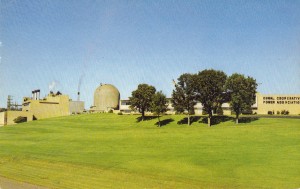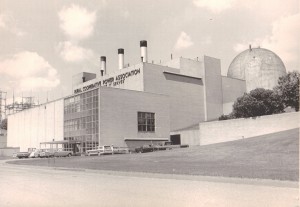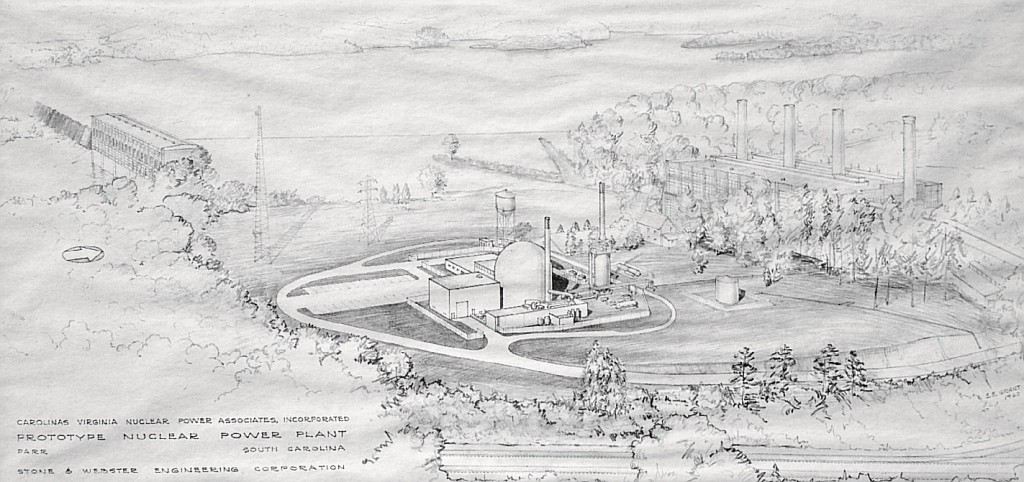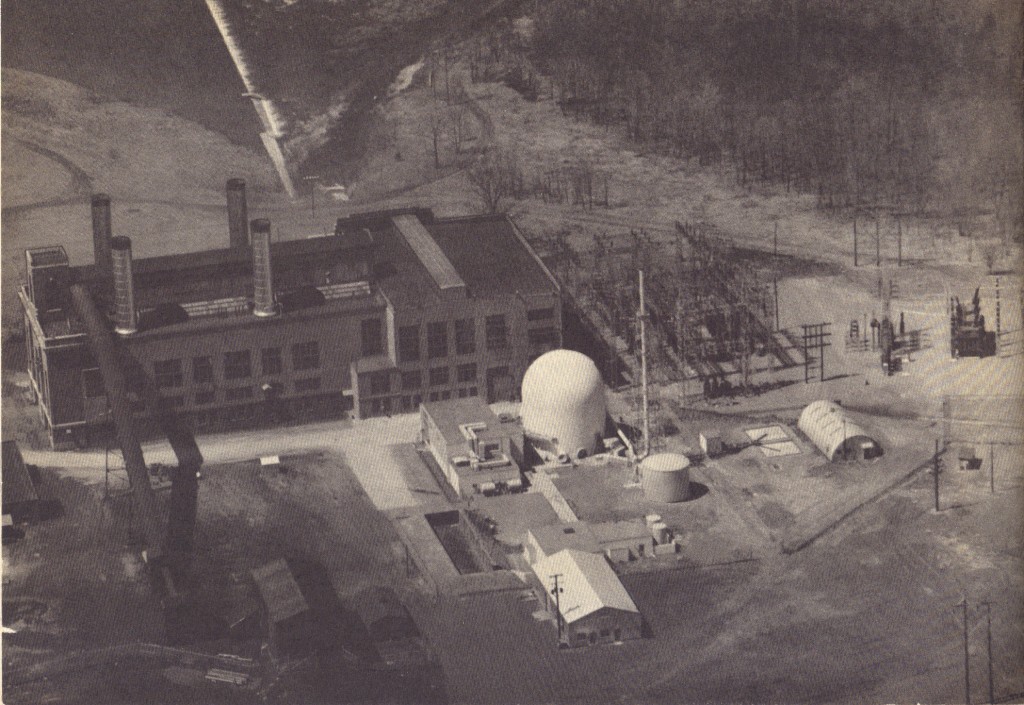The Hook-Ons
This week's announcement by Babcock & Wilcox that it had signed the long-awaited funding agreement with the Department of Energy has been taken by advocates of small modular reactors (SMRs) as just the latest good news on the inevitable path to construction of at least one prototype nuclear plant using SMR reactor technology in the United States. It is widely hoped that this is the harbinger of the rapid spread of the market for SMR plants.
The chief advantage of SMRs other than cost reduction over large 1000-1600 MWe nuclear plants is that they can be located practically anywhere (assuming proper geologic characteristics and supply of cooling), since a primary design feature is that the major components of the reactor plant itself are to be easy to ship (i.e., by large truck over existing highways). This design asset potentially opens up locations previously considered unworkable (for large plants, with their enormous reactor vessels and other equipment that needs to be shipped intact to site) and may, in some cases, allow siting of SMR-driven power plants nearer to populated areas in order to take advantage of benefits to the grid (by siting source nearer to use) and even, if some have their way, to supply steam for process use to facilities already in existence or built new.
These concepts-siting closer to communities than with large commercial plants, and supply of steam for existing facilities-are, in fact, not new. In the early days of nuclear energy, a number of nuclear plants were built in order to supply steam to facilities already in use. In the cases of these early reactors, the facilities were all commercial electric power stations; the group of reactors came very loosely to be known as "hook-on" reactors. The concept of expanding the use of nuclear energy in such a way was actively pushed by the Atomic Energy Commission; three of the four plants we're about to explore were (at least partly) funded under the AEC Power Demonstration Reactor Program.
Elk River (Minnesota)
The Elk River Reactor, widely heralded as "Rural America's First Atomic Power Plant," was originally contracted to ACF Industries in 1959 for construction behind the Rural Co-Operative Power Association's Elk River coal-fired plant (seen at far left in the above post card photo.) The reactor plant was a novel natural circulation, indirect cycle boiling water reactor that, while not fitting the modern definition of "small, modular" of today's SMRs, did have a reactor vessel small enough to be shipped to the site on the smallest standard railroad flat car of the time (said cars measured 40 feet in length overall.) The 58-MWt reactor produced saturated steam at 922 psig and 536 °F, but the existing turbines in the plant required superheated steam. Construction of a coal-fired superheater interposed between the reactor plant and the power plant adjusted the steam conditions to 612 psig but 825 °F; of the total 22 MWe of generating capacity credited this installation, 7 MW was provided by the superheater.
The plant suffered teething pains that, today, seem not too surprising given the facts that the original reactor vendor was small, and that it was actually bought out by Allis-Chalmers while construction of the Elk River Reactor was in progress. Fuel element defects and reactor pressure vessel cladding cracks contributed (among other things) to delays in the start up of the plant, which did not achieve commercial operation until mid-1965, but after which operated with a very fair degree of reliability.
Eventually, further leakage from welds in the primary coolant system caused investigation into the overall condition of all welds in that system in 1968, and the determination was made that major rework would be required to fix the problems-a problem that looked all the worse given that Allis-Chalmers had decided to exit the nuclear power business in 1966. After considerable debate about what to do with the reactor plant (which was still technically AEC owned), the decision was made in March 1971 to decommission the reactor plant and completely remove it from the site. Below, a March 1971 UPI telephoto showing the plant as it looked at the time that the decommissioning decision was made.
Piqua (Ohio)
The Piqua Nuclear Power Facility (PNPF) was built in the early 1960s in the town of Piqua, Ohio, as a part of the second round of the AEC Power Demonstration Reactor Program. The reactor was unique among the world's commercial power reactors in being an organic-cooled and -moderated design. A commercial terphenyl preparation (marketed widely as Santowax-OMP by Monsanto) was used for this plant that, because of the low pressure of the primary, originally was designed without any containment whatsoever. The Advisory Committee on Reactor Safeguards, however, ordered that a containment be built. The reactor plant was built just across and down the river from the original Piqua municipal generating station, and supplied steam to it at 450 psia and 550 ºF through underground piping and a new bridge structure over the river. The reactor was rated 46 MWt, and the electric generating capacity credited to it was 11.4 MWe.
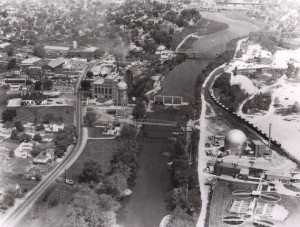
The Piqua Nuclear Power Facility is seen on the right, which is the east side of the Miami River; the municipal power plant is on the West side, just upstream.
PNPF began operation in 1963 and operated with occasional problems largely due to coolant breakdown until 1968 when a serious blockage occurred. The decision was made by the city of Piqua not to take over ownership of the plant, and it entered procedures to shut down and decommission immediately. The disposal method (after defueling) was selected by the AEC was SAFSTOR, in which the plant is left in place to allow decay of radioactivity at the same time guaranteeing no impact to the surroundings. The containment and support buildings are still clearly visible in Piqua to this day.
CVTR (South Carolina)
The Carolinas-Virginia Tube Reactor was built adjacent to an existing coal-fired plant (and hydroelectric dam facility) at Parr, South Carolina, under the third round of the AEC Power Demonstration Reactor Program in order to test out the pressure tube reactor concept. This plant was widely reported and heralded in the early 1960s as "The Southeast's First Atomic Power Plant." Westinghouse provided the 65-MWt pressurized (tube type) heavy water cooled and moderated reactor; Stone and Webster acted as architect-engineer. The plant (like Elk River, but unlike Piqua) required external superheating; of the rated electrical 17 MWe, 1.7 MWe was contributed by the superheater. The reactor and superheater provided steam at 415 psia and 725 ºF to the old powerhouse near by.
Carolinas-Virginia Nuclear Power Associates owned this plant; this organization was comprised of Duke Power Company, Carolina Power & Light Company, South Carolina Electric & Gas Company, and Virginia Electric and Power Company (the latter often referred to as VEPCO).
Below, a spectacular original pencil rendering of the CVTR plant facility, including the powerhouse and environs, from my collection. The drawing's labeling is clear when blown up; it is signed "E.E. Grant 1960." (Click to enlarge.)
The CVTR started up in 1962, and like the other plants we've shown so far, had a very short operating life (five years,) shutting down for good in 1967. The reactor was in SAFSTOR condition for many years, but in much more recent times has completely been decommissioned and removed, and today there is very little sign that the plant was ever there. Of course, the site of the former Parr generating station and the adjacent CVTR installation is quite near the Virgil C. Summer Nuclear Generating Station, which today is seeing construction of two Westinghouse AP1000 plants-so that the area of "The Southeast's First Atomic Power Plant" is again at the cutting edge of nuclear energy's advance.
Saxton (Pennsylvania)
A fourth early reactor actually is one that contributed the least to commercial power generation of those we're visiting here, and is also that which is most commonly found in the literature to have the appellation "hook on".
The Saxton Generating Station was selected to host construction of a nuclear reactor whose primary purpose was developmental testing of fuels, and which was to be officially known as the Saxton Experimental Nuclear Reactor. Owner of the reactor was Saxton Nuclear Experimental Corporation, a non-profit entity formed by Pennsylvania Electric Company, Metropolitan Edison Company, New Jersey Power and Light Company, and Jersey Central Power and Light Company-all of which were subsidiary companies of GPU or the General Public Utilities System. The diminutive pressurized water reactor, rated originally 20 MWt, had only a single loop (and thus one coolant pump and one steam generator) and provided steam to the center of Saxton Generating Station's three turbine generators. While the containment was clearly visible beside the coal-fired plant, for safety reasons (considering the surrounding community) the reactor vessel was actually located some 15 feet below grade.
According to the February 1959 Atomic Industrial Forum "Forum Memo" magazine, in which the contract for the reactor was revealed, GPU had actually announced that it was considering a "hook on" at Saxton back in 1957 after terminating an investigation into building a pressurized water reactor in the Philippines (another GPU subsidiary was Manila Electric Company.) At that time, the rating of the Saxton plant was given as a very modest 5000 ekw (which we would now write as 5 MWe), although in point of fact later testing was planned at far above the original rated figures; the turbine to which the reactor piped steam was actually rated nominally at 13 MWe, allowing considerable room for uprating for temporary testing.
In the March 1959 issue of the Forum Memo, Elmer L. Lindseth, president of Cleveland Electric Illuminating Company and chairman of the Edison Electric Institute's Committee on Atomic Power, was quoted as saying that Westinghouse would build the Saxton reactor plant at a fixed price of $6.25 million. GPU would under the same agreement provide the site, use of the No. 2 turbine, and bear operating and maintenance costs-all of which figured to roughly $2 million. Westinghouse also had exclusive fuel production rights for five years.
With Gilbert Associates serving as architect-engineer, construction of this unique "hook on" began in February 1960 (with AEC Construction Permit CPPR-6.) A provisional operating license was issued in November 1961, and the reactor fueled in early April 1962, with criticality achieved at 1:40 AM on April 13, 1962. (Below, a view of the Saxton Experimental Nuclear Reactor next to the Saxton Generating Station.)
As has been mentioned, this plant was not entirely intended as a commercial power reactor; rather, its focus was the development of technology for further, future reactors. Quoting GPU in a Saxton advertising brochure of the day, "Investor owned utilities, dedicated to serving consumers in all walks of life, have invested $8,500,000 of private funds in the nation's newest operational nuclear reactor so that 'unknowns' can be converted into 'knowns' and personnel can acquire valuable operating experience for use in designing and manning larger reactors in the future."
Among other concepts, Saxton experimented with chemical control of reactivity ("chemical shim," or use of boron in the primary coolant to control reactivity instead of just control rods) and also conducted extended operations with plutonium fuel (MOX or "Mixed OXide" fuel, containing both natural uranium dioxide and plutonium dioxide) beginning in the mid-late 1960s.
As a result of the nature of the program, it appears in retrospect that the plant spent as much of its life operating as not. From the 1964 AEC Report to Congress: "The Saxton Nuclear Experimental Corp.'s pressurized light water reactor near Altoona, Pa., was returned to power operation on January 30, after having been shut down since the previous November for modifications. The reactor, while producing small amounts of electric power, is primarily used for experiments to determine ways in which more heat energy can be obtained from specified amounts of fuel." It would thus in hindsight be appropriate to consider that the waste heat from the Saxton reactor was not entirely wasted, if we simply view it as a byproduct of advanced fuels testing, by way of connecting the plant to the Saxton Generating Station.
Saxton was finally shut down in May 1972, and after a prolonged period of decommissioning, there is nothing visible at the site to hint that a power station of any sort once existed there. The entire power plant and reactor facility has been removed down to several feet below grade, and the area has been backfilled.
In closing, it's interesting to consider the notion that today's concept of placing lower output, transportable nuclear reactors at a now-expanded range of possible locations actually had a roughly correlative precedent early in the construction of nuclear power stations in this country. In the siting of plants nearer to populated areas, and in the use of small plants on grids that could not handle extremely large single generating sources, the early experience was perhaps a herald of things to come, even if it did take another roughly half century and the development of truly integrated, truck transportable, and inherently safe SMRs in order to realize the dream held up for these early small plants. The wide design disparity and newness of the technology associated with these early plants seemed to hint at troubles, which surely were encountered, but today nuclear technology is a half century further down the road so that the question of operability is quite far removed from consideration. As it turns out, everything old is new again-but today, with far better promise of success.
(All illustrations - Will Davis collection. Please do not reproduce without permission.)
("Atomic Industrial Forum" was a trade group formed in 1953; it is a lineal predecessor of today's Nuclear Energy Institute.)
______________________________
 Will Davis is a consultant to, and writer for, the American Nuclear Society. In addition to this, he is a contributing author for Fuel Cycle Week, and also writes his own blog Atomic Power Review. Davis is a former US Navy Reactor Operator, qualified on S8G and S5W plants.
Will Davis is a consultant to, and writer for, the American Nuclear Society. In addition to this, he is a contributing author for Fuel Cycle Week, and also writes his own blog Atomic Power Review. Davis is a former US Navy Reactor Operator, qualified on S8G and S5W plants.


